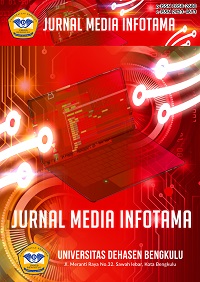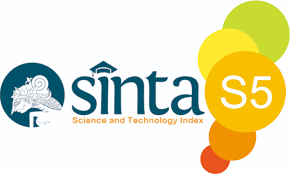Pengembangan Aplikasi Pariwisata Kotawaringin Barat Berbasis GIS Menuju Smart Tourism City
Abstract
West Kotawaringin Regency is located in Central Kalimantan Province, Indonesia. This regency has great potential in its tourism. The local government support the tourism by prioritizing the tourism in the local goverment's program, alongside with infrastructure and agriculture. One of the famous tourist attractions in West Kotawaringin Regency which attracts many visitors both local and foreign visitors is Tanjung Puting National Park (TPNP). TPNP is the natural habitat for the Orang Utan, the indigineous and protected fauna from Kalimantan and some areas of Sumatra. Besides TPNP, West Kotawaringin Regency also has some cultural attractions since this regency has a kingdom named The Sultanate of Kutaringin. This regency also has another tourism attractions such as beach attractions, river cruise, souvenir shopping, and local culinary attractions. Although this regency has various tourist attractions, Kotawaringin Barat Regency has not conducted a good tourism governance. At the moment, many tourists just focused only in visiting TPNP. This happened because of their lacking information about the other tourist attractions that this regency serves. Because of this problem, this study is aimed to create a GIS tourism application that is able to provide information to all potential tourists about various attractions that the the regency has. It is hoped that this application will make the tourist visits in the West Kotawaringin area will become more evenly distributed to make West Kotawaringin a Smart Tourism City which will lead to economic equality for the community and tourism activists.
Downloads
References
[2] ramzi, “Jarak Palangkaraya Antar Kabupaten Di Kalimantan Tengah,” 2019.
[3] BPS_Kalteng, “Pendapatan Kabupaten/Kota/Provinsi (Ribu Rupiah), 2013-2014,” 2014.
[4] DPMPTSP_Kobar, “Promosikan Potensi Investasi Di Kobar, Dinas PMPTSP Siapkan Peta Potensi Investasi Berbasis GIS.” https://dpmptsp.kotawaringinbaratkab.go.id/beritadetail/bWF6ZktwZlVRUHI4cWtkdUV2ekFXUT09 (accessed Apr. 07, 2023).
[5] S. Untung, “Kotawaringin Barat Jadikan Pariwisata Sebagai Sektor Unggulan,” Info Publik. [Online]. Available: https://infopublik.id/read/249634/kotawaringin-barat-jadikan-pariwisata-sebagai-sektor-unggulan.html
[6] N. Salsabil, “Pengembangan Objek Wisata Taman Nasional Tanjung Puting Oleh Dinas Pariwisata Kabupaten Kotawaringin Barat Provinsi Kalimantan Tengah,” Institut Pemerintahan Dalam Negeri, 2022. [Online]. Available: http://eprints.ipdn.ac.id/9814/
[7] D. A. Rahman, “Karakteristik Habitat dan Preferensi Pohon Sarang Orangutan (Pongo pygmaeus wurmbii) di Taman Nasional Tanjung Puting (Studi Kasus Camp Leakey),” J. Primatol. Indones., vol. 7, pp. 37–50, 2010, [Online]. Available: https://primata.ipb.ac.id/wp-content/uploads/2022/06/Vol-7-No-2-2010-Karakteristik-Habitat-dan-Preferensi-Pohon-Sarang-Orangutan-Pongo-Pygmaeus-Wurmbii-di-Taman-Nasional-Tanjung-Puting-Studi-Kasus-Camp-Leakey.pdf
[8] Kemendikbud, “Digitalisasi Data Keraton,” 2018. [Online]. Available: https://kebudayaan.kemdikbud.go.id/ditkt/wp-content/uploads/sites/6/2018/11/Istana-Kuning-Kotawaringin-Barat.pdf
[9] H. Lee and S. Hlee, “The Intra- and Inter-Regional Economic Effects of Smart Tourism City Seoul: Analysis Using an Input-Output Model,” MDPI, vol. 13, no. 7, pp. 4–16, 2021, Accessed: Apr. 07, 2023. [Online]. Available: file:///C:/Users/G-A-H/Downloads/sustainability-13-04031.pdf
[10] P. Lee, W. C. Hunter, and N. Chung, “Smart Tourism City: Developments and Transformations,” Sustainability, vol. 12, no. 10, pp. 1–15, 2020, [Online]. Available: https://www.mdpi.com/2071-1050/12/10/3958
[11] A. K. Jebur, “Uses and Applications of Geographic Information Systems,” Saudi J. Civ. Eng., vol. 5, no. 2, pp. 18–25, 2021, [Online]. Available: https://saudijournals.com/media/articles/SJCE_52_18-25.pdf
[12] S. Bhatia, “G-Tourism: Using GIS in tourism,” 2018. [Online]. Available: https://www.geospatialworld.net/blogs/gis-in-tourism/
[13] I. M. P. Mertha, V. Simadiputra, E. Setyawan, and Suharjito, “Implementasi WebGIS untuk Pemetaan Objek Wisata Kota Jakarta Barat dengan Metode Location Based Service menggunakan Google Maps API,” J. Nas. Inform. dan Teknol. Jar., vol. 4, no. 1, 2019, [Online]. Available: https://www.researchgate.net/publication/338223228_Implementasi_WebGIS_untuk_Pemetaan_Objek_Wisata_Kota_Jakarta_Barat_dengan_Metode_Location_Based_Service_menggunakan_Google_Maps_API
[14] A. Hermawan, M. Awaluddin, and B. D. Yuwono, “Pembuatan Aplikasi Webgis Informasi Pariwisata Dan Fasilitas Pendukungnya Di Kabupaten Kudus,” J. Geod. Undip, vol. 6, no. 4, pp. 51–59, 2017.
[15] Mukasa, Y and Yamamoto, K, “A Sightseeing Spot Recommendation System for Urban Smart Tourism Based on Users’ Priority Conditions,” Journal of Civil Engineering and Architecture, Vol 13, pp 622-640, 2019.
[16] S. Herawati, Y. D. P. Negara, H. F. Febriansyah, and D. A. Fatah, “Application of the Waterfall Method on a Web-Based Job Training Management Information System at Trunojoyo University Madura,” in E3S Web of Conferences, 2021, pp. 1–6
Copyright (c) 2023 Gregorius Anung Hanindito, Jamaludin Dwi Laspandi

This work is licensed under a Creative Commons Attribution-ShareAlike 4.0 International License.
An author who publishes in Jurnal Media Infotama agrees to the following terms:The author holds the copyright and grants the journal the right of first publication of the work simultaneously licensed under the Creative Commons Attribution-Share Alike 4.0 License which allows others to share the work with acknowledgment of the work's authorship and initial publication in this journal.Submission of a manuscript implies that the submitted work has not been previously published (except as part of a thesis or report, or abstract); that it is not being considered for publication elsewhere; that its publication has been approved by all co-authors. If and when a manuscript is accepted for publication, the author retains the copyright and retains the publishing rights without limitation.
For new inventions, authors are advised to administer the patent before publication. The license type is CC-BY-SA 4.0.
MEDIA INFORMATION REVIEW: Journal of the Faculty of Computer Science is licensed under a Creative Commons Attribution-ShareAlike 4.0 International License.You are free to:Share
— copy and redistribute material in any medium or formatAdapt
— remix, modify and develop materialfor any purpose, even commercial.
The licensor cannot revoke this freedom as long as you follow the license terms












.png)


